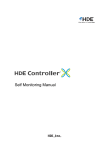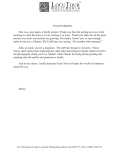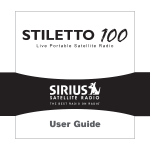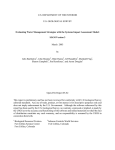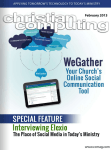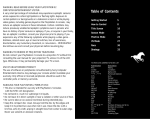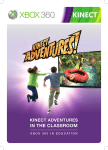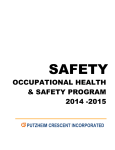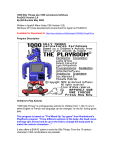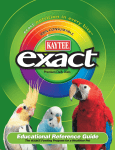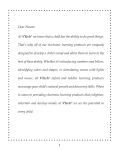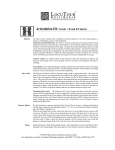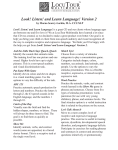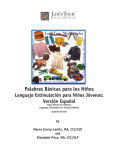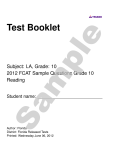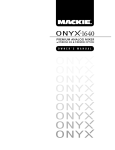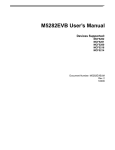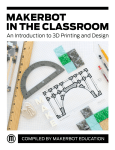Download Basic Words for Children
Transcript
LOCUTOUR ™ M U L T I M E D I A Basic Words for Children Language Stimulation for Young Children: Version 2 by Marna Scarry-Larkin, MA, CCC/SLP and Elizabeth Price, MA, CCC/SLP LOCUTOUR ™ M U L T I M E D I A Basic Words for Children Language Stimulation for Young Children Spanish Translation by: Andrea Ritchie, MA, CCC/SLP This CD is loaded with our favorite speech and language programs for young children. The building blocks for the development of articulate speech, excellent word knowledge, correct grammar, and fast, accurate reading are all here. Parents, caregivers, and professionals working on oral and written language skills will appreciate the scope of these programs. Children will appreciate how much fun they are! 100 Basic Words Video; Food; Clothing; Toys; Eight user-definable buttons for saving groups of pictures This program presents a basic vocabulary for children acquiring their first words. It provides several language modeling techniques including: the target word alone, a phrase in “parentese” that a parent might use with a very young child, a question, a carrier phrase (It’s a...), and several longer models--a descriptive phrase, a descriptive sentence, and a functional sentence. Wild, Woolly, Wonderful Critters! House; Ranch/Farm; Forest; Mountain; Desert; Insects; River/Lake; Ocean; Africa; Jungle; Prairie; Tundra/Arctic WWW. Critters, as it is fondly referred to in our office, presents eight stimuli for each of 120 animal pictures. For young children, the first four stimuli might be most appropriate. These are: the word alone, a phrase in “parentese” to capture the child’s attention, a carrier phrase“It’s a...”, and the question, “What is it?”. Older children will enjoy the last four buttons: a phrase, descriptive sentence, a functional sentence that gives an interesting piece of information about the animal, and the initial sound of the word. The photographic and written stimuli are arranged hierarchically. They begin with familiar animals around the house, continue through animals in jungles, oceans, and other habitats of the world, and end with less well-known animals in the arctic climate. The one category that is not by habitat is the Insect category, since insects are in all habitats! You will undoubtedly notice that some animals could be located in more than one habitat. While it was difficult to make a final determination about where to place each animal, we chose these groupings based on where the photograph was taken and the logic of keeping animals in familiar settings, which should lead to easier recall of the word. And a One, Two, Three! One Syllable; Two Syllables; Three Syllables; Four Syllables; Five Syllables; Six Syllables, 1-3 Syllables; 4-6 Syllables; Mixed This syllable segmentation game is a great tool for stimulating auditory processing and expressive language. The difficulty levels are easily controlled by choosing 1-6 syllables for expressive practice. The “Record and Play” feature allows children to record their own speech, and listen to it. There are 360 words to practice and each has a corresponding picture to help with recall and vocabulary stimulation. Many words in the three - six syllable groups are difficult and may require a dictionary or assistance for vocabulary development. ABC What’s My Name?; What’s My Sound?; What’s My Alphabet?; What’s My IPA Symbol? This simple game shows the sounds, symbols, and alphabet names for the English alphabet. It also has a “Record and Playback” feature to listen to productions of the sounds. © 1996-2007 LocuTour Multimedia, Inc. All Rights Reserved. For more information visit www.LocuTour.com or call 800.777.3166 or 805.544.0775.. LOCUTOUR ™ M U L T I M E D I A Who will want to play this game? This game is intended for young children who find playing on the computer a fun way to learn. Some children enjoy sitting at the computer with parents, teachers or older siblings. This simple language program encourages turn-taking, imitating, describing, questioning, answering, and playing with sounds and words. How do children learn to talk? They learn how to talk by listening and imitating. This program provides several different language modeling techniques to encourage both receptive and expressive language development. Children can hear the item named in isolation, in a phrase, or sentence. Additional sentences are provided to emphasize descriptive or functional elements of the item. The button labeled Parentese (gender neutral “Parent - ese” Robert Owens, 1996) provides a modified utterance that a parent might use with a very young child. Characteristics of parentese include more restricted vocabulary, references to what’s happening right now, shorter and less complex utterances, more repetitions, slow and exaggerated speech. Examples from these CDs include: “soft jammies”, “Look! A dress”, “pop-pop-bubbles”, “big bucket”, “no spoon”, “pijamas suaves”, “¡Mira! Un vestido!”, “pincha, pincha, burbujas”, “cubo grande”, and “¡sin cuchara!” Why are these words included on the CD? These words are representative of the first words many children will learn. We recognize that each child’s first vocabulary is different. Typically, a child will learn animal names and sounds in addition to clothing, toys, food, and actions. Some children’s first words will not be included in this list at all. One author’s child’s first words were “blimp” and “bologna”. The other author’s child’s first word was, “apple”. There is an interest factor in what children choose to learn to talk about. Is the computer an appropriate tool for teaching language? Children talk about what they hear, see, feel, smell, and taste. The purpose of language is to communicate experiences. The first communication dyads are child-mother, child-father, and child-sibling, etc. One individual has wishes and desires to express something to another with the expectation that there is understanding of the message. We call this communication. When the computer is used as a tool to present pictures of items not necessarily in the immediate environment, the child’s world is expanded. The parents, caregivers, or therapists can expand on the language concepts presented, to make them relevant to the child’s world. For example, when pajamas appear on the screen, they might label the pajamas in the picture, then talk about the child’s own pair of pajamas. They can talk about how the child’s pajamas are the same as, and how they are different from, the picture on the screen. How is the accuracy of speech production determined? The computer does not determine the accuracy of the speech production. The clinician or the child must determine the accuracy and may use the computer to tally the Correct and Incorrect productions. Click on the Spontaneous Correct/Incorrect and the Imitative Correct/Buttons to have the program tally and report the accuracy of the speech production. © 1996-2007 LocuTour Multimedia, Inc. All Rights Reserved. For more information visit www.LocuTour.com or call 800.777.3166 or 805.544.0775.. LOCUTOUR ™ M U L T I M E D I A 100 Basic Words Videos; Food; Clothing; Toys Eight user-definable buttons for saving groups of pictures Objective The child will see a picture and hear it labeled. The communication partner may select from one to eight language models from the prerecorded buttons, or can record an individualized model on the button labeled Your Text. If the child is under three, the communication partner might prefer the models provided by the buttons on the top row: Word, Parentese, It’s a..., and What (is it)? Most are self-explanatory. The Parentese button provides a modified utterance that a parent might use with a very young child (see How do Children Learn to Talk? in the introduction to this manual). The buttons on the bottom row are more appropriate for children over three: (Descriptive) Phrase, (Descriptive) Sentence, Function (Sentence), and Initial (Sound). How to Play The communication partner will assist the child in choosing a series of target words. The child will listen to a word as it is pronounced and try to replicate the sound. The child may listen to the word again by clicking on the Word button, then use the record button to record their voice. The Parentese button will provide a model that a parent might use with a very young child. The child may click on the What (is it)? button to listen and respond to a direct question. The child can use the It’s a... button to listen, then copy the short sentence containing the target word. For a longer model the child can choose any or all of the descriptive buttons--Phrase, Sentence, Function--and record their imitation of the model. In the Initial (Sound) button we call attention to the first sound of the target word. When the first sound is “B” the sound matches the symbol /b/. However, there are instances when the sound is different from what you might expect. The most common is letter “C”. Letter “C” can sound like /k/ or /s/ (comb, cereal). Letter “G” can sound like /g/, /j/, or /h/ (great horned owl, giraffe, Gila monster). In these instances you need to notice the difference between the sound and the spelling. Some other examples are: shirt starts with /sh/, cheese starts with /ch/, orange starts with /or/, airplane starts with /air/, whispering starts with /wh/, and throwing starts with /th/. When you are finished with a screen, click on the right arrow or use the right arrow key to move to the next screen. The left arrow allows you to repeat the previous screen. The up arrow key or the up arrow on the volume button increases the volume and the down arrow decreases the volume. If you turn the volume off, you can scroll faster through the pictures using the right or left arrow keys. H takes you to the Help screen. X allows a quick exit from the program. The Print button allows you to print the picture on a homework page. Refer to I Like Keys for more keyboard shortcuts. Monitoring and Self-Monitoring The communication partner can track spontaneous and imitative responses and whether these responses were correct or incorrect by clicking on Spontaneous Correct (or type Z), Z Spontaneous Incorrect (A), Imitative Correct (C), or Imitative Incorrect (II or E). Use the “Record and Play” feature (described below) to record and listen to the child's production of the target. Alternate between the model and the child's recorded words. Stress the importance of the concept that, “Contrast aids perception.” Listen for the similarities and differences between the two productions. Have older children monitor their own speech and determine accuracy using the CI buttons. Compare the child's perception of accuracy with your own. You may use the CI buttons each time the child says the target word to keep a running tally of accuracy. Recording Options You can record voices using two buttons at the right of the screen that are labeled Your Text. When you click on one of the buttons, the Record button will change from gray to black with a red dot. Click on the Record button. The button will change to Stop. Say your sound. When you are finished recording, click on Stop. You can play back the sound by clicking on the Your Text button that you selected when you started recording. © 1996-2007 LocuTour Multimedia, Inc. All Rights Reserved. For more information visit www.LocuTour.com or call 800.777.3166 or 805.544.0775.. LOCUTOUR ™ M U L T I M E D I A Transfer activities Talk about real objects and actions in the child’s environment that are similar to the ones on the CD. Talk about what is the same and what is different between the pictures and the objects. Demonstrate and talk about the use of the objects, or perform and talk about the actions the child sees on the screen. Ask the child to draw and/or color a picture of the object or action. Print the pictures and make a vocabulary book. Have the child play “charades” by gesturing the actions on the videos or gesturing the use of the objects. Older children might be able to name other words that start with the same sound as the target word. The communication partner can select several pictures from each group and ask the child to categorize them verbally as they play on the screen. Generalization This can be practiced by recording “spontaneous conversations” that have the target word used somewhere in the conversation. The record feature will allow several minutes of recording if there is room on your hard drive to save the file temporarily. Permanent storage of recordings is possible. See the Options 2 section for details. Options Random/Sequential; Display Words, Phrases, and Sentences/Hide Words, Phrases, and Sentences; Finish Speech/Interrupt Speech; Play Each Sound, then Go to the Next Picture Random/Sequential: When the random option is chosen the pictures display in a randomly chosen order. They will continue to play in this order for subsequent trials in the same category. Option R will toggle the random feature on and off. Display Words, Phrases, and Sentences/Hide Words, Phrases, and Sentences: Choose this option to hide the typewritten text underneath the pictures. Option H will toggle the Display Words/Hide Words feature while the words are on the screen. Finish Speech/Interrupt Speech: The interrupt speech option allows you to click anywhere on the printed text and stop the computer’s speech. This is helpful if you want to present, for example, a sentence completion task. Choose finish speech if you want the speech to continue despite random clicks on the screen (from click-happy children!). Uninterrupted play of the stimuli is achieved by clicking on, “Play each sound then go to the next picture.” Options 2 Type the password, Options, in the space after, “More Options: Enter Password.” The second page of options requires a password because quick little fingers can change your plans for therapy when you aren’t looking. Choose Picture Sets allows you to control which pictures are presented. You can establish up to eight picture sets which are saved from session to session. You can name the sets to assist you in remembering which pictures were chosen. Click on the Choose Picture Sets button to display a screen with selection buttons and the current name for eight sets. Highlight the name and type over it to change the name. The name you choose will be displayed on the main screen of the game. You can group the words any way you wish. You might choose to establish sets by child, “John’s Words”, subject, “Food”, “Actions”, or objective, “pre-Tx”, “post-Tx”. Double-click on the button next to the set name or click on the Choose Pictures button to choose which pictures belong to the selected set. When you have finished picking pictures for a set, click on the Finished button. This will return you to the screen with the set labels. Click on the Return button to return to the Options screen. Save Recordings The default is to not save any recordings. If you want to save recordings so that they are available for the next session, choose Save New Recordings. Any new recording that is made for a word, phrase, or sentence will be saved and available for future use. If this option is selected any recording that is done during the session will erase the previous sounds and words for the button that is selected when the recording is made. © 1996-2007 LocuTour Multimedia, Inc. All Rights Reserved. For more information visit www.LocuTour.com or call 800.777.3166 or 805.544.0775.. LOCUTOUR ™ M U L T I M E D I A Lock Finish Button allows you to prevent children from exiting the game too soon. You can bypass the lock by typing the key combination “Control F” (Finish). Be careful to keep this trick a secret. Note: You must have the game set to allow keyboard entry before it will recognize the “Control F” keys. To turn on keyboard entry (if it is off) type “Control T” (Type). Choose First Speech Sound allows you to choose which stimuli you want presented first. If you have a child that is unable to break a “What is it?” perseveration, you may want to start with, “It’s a...”. Further along in the program you may want to have sentences as the first speech model. The default is to start on the left with Word and move sequentially through all the buttons. If you haven’t taped anything under the Your Text buttons, the computer will not play any sound when that button is selected for the first speech sound. Allow Keyboard Entry The program will allow you to type in your own labels for each picture under the buttons Your Text. The default is to allow keyboard entry. If Keyboard Entry is allowed, then the keyboard shortcut keys are not active. Use the key combination, “Control T” to toggle between allowing typing and not allowing it. Note: This option does not control whether the words are saved. That option is controlled by the Save Recordings option as described above. Categories Screens Game Results Five of the buttons on the main screen are permanently set to display specific pictures. The top four buttons each display 25 pictures or videos, and the Mixed button displays all 100 pictures–randomly chosen. The label and picture sets for the remaining eight buttons can be determined by the communication partner. The second Options screen is used to change the labels and select the pictures. It is possible to label set 1 as “Pat’s words” or “Week 1” and devise a lesson plan for each word. To get to the second options screen, choose Options from the main screen, then enter the password and press Return. The password is the word Options. The password should keep children from changing the options on Options 2, but not be too difficult to remember. It is not changeable, so don’t let children see you enter it. 75 Photographs, 25 Videos By Picture Set: Number of Spontaneous Correct and Incorrect Productions, Number of Imitative Correct and Incorrect Productions, Number of Pictures Viewed and Seconds Viewed. REFERENCE Owens, R. (1996). Language development: an introduction. Boston, MA: Allyn & Bacon. © 1996-2007 LocuTour Multimedia, Inc. All Rights Reserved. For more information visit www.LocuTour.com or call 800.777.3166 or 805.544.0775.. LOCUTOUR ™ M U L T I M E D I A Wild, Woolly, Wonderful Critters! House; Ranch/Farm; Forest; Mountain; Desert; Insects; River/Lake; Ocean; Africa; Jungle; Prairie; Tundra/Arctic Objective How to Play The child will see a picture and hear it labeled. The communication partner may select from one to eight language models from the prerecorded buttons, or can record an individualized model on the button labeled Your Text. If the child is under three, the communication partner might prefer the models provided by the buttons on the top row: Word, Parentese, It’s a..., and What (is it)? The Parentese button provides a modified utterance that a parent might use with a very young child (see How do Children Learn to Talk? in the introduction to this manual). The buttons on the bottom row are more appropriate for children over three: (Descriptive) Phrase, (Descriptive) Sentence, Function (Sentence), and Initial (Sound). The communication partner will assist the child in choosing a series of target words. The child will listen to a word as it is pronounced and try to replicate the sound. The child may listen to the word again by clicking on the Word button, then use the record button to record their voice. The Parentese button will provide a model that a parent might use with a very young child. The child may click on the What (is it)? button to listen and respond to a direct question. The child can use the It’s a... button to listen, then copy the short sentence containing the target word. For a longer model the child can choose any or all of the descriptive buttons--Phrase, Sentence, Function--and record their imitation of the model. In the Initial (Sound) button we chose to call attention to the first sound of the target word. When the first sound is “B” the sound matches the symbol /b/. However, there are instances when the sound is different from what you might expect. The most common is letter “C”. Letter “C” can sound like /k/ or /s/ (cat, city critter). Letter “G” can sound like /g/, /j/, or /h/ (great horned owl, giraffe, Gila monster). In these instances you need to notice the difference between the sound and the spelling. Some other examples are: ptarmigan starts with /t/, arctic fox starts with /ar/, and cheetah starts with /ch/. When you are finished with a screen, click on the right arrow or use the right arrow key to move to the next screen. The left arrow allows you to repeat the previous screen. The up arrow key or the up arrow on the volume button increases the volume and the down arrow decreases the volume. If you turn the volume off, you can scroll faster through the pictures using the right or left arrow keys. H takes you to the Help screen. X allows a quick exit from the program. The Print button allows you to print the picture on a homework page. Refer to I Like Keys for more keyboard shortcuts. Monitoring and Self-Monitoring The communication partner can track spontaneous and imitative responses and whether these responses were correct or incorrect by clicking on Spontaneous Correct (or type Z), Spontaneous Incorrect (A), Imitative Correct (C), or Imitative Incorrect (II or E). Use the “Record and Play” feature (described below) to record and listen to the child's production of the target. Alternate between the model and the child's recorded words. Stress the importance of the concept that, “Contrast aids perception.”Listen for the similarities and differences between the two productions. Have older children monitor their own speech and determine accuracy using the CI buttons. Compare the child's perception of accuracy with your own. You may use the CI buttons each time the child says the target word to keep a running tally of accuracy. Recording Options Transfer activities You can record voices using two buttons at the right of the screen that are labeled Your Text. When you click on one of the buttons, the Record button will change from gray to black with a red dot. Click on the Record button. The button will change to Stop. Say your sound. When you are finished recording, click on Stop. You can play back the sound by clicking on the Your Text button that you selected when you started recording. Talk about real animals in the child’s environment that are similar to the ones on the CD. Talk about what is the same and what is different between the picture and the real animal. Ask the child to draw and/or color a picture of the animal. Print the pictures and make a vocabulary book. Have the child play “charades” by gesturing the animal. Older children might be able to name other words that start with the same sound as the target word. The communication partner can select several pictures from each group and ask the child to categorize them by habitat as they play on the screen. © 1996-2007 LocuTour Multimedia, Inc. All Rights Reserved. For more information visit www.LocuTour.com or call 800.777.3166 or 805.544.0775.. LOCUTOUR ™ M U L T I M E D I A Generalization This can be practiced by recording “spontaneous conversations” that have the target word used somewhere in the conversation. The record feature will allow several minutes of recording if there is room on your hard drive to save the file temporarily. Permanent storage of recordings is possible. See the Options 2 section for details. Options Random/Sequential; Display Words, Phrases, and Sentences/Hide Words, Phrases, and Sentences; Finish Speech/Interrupt Speech; Play Each Sound, then Go to the Next Picture Random/Sequential: When the random option is chosen the pictures display in a randomly chosen order. They will continue to play in this order for subsequent trials in the same category. Option R will toggle the random feature on and off. Display Words, Phrases, and Sentences/Hide Words, Phrases, and Sentences: Choose this option to hide the typewritten text underneath the pictures. Option H will toggle the Display Words/Hide Words feature while the words are on the screen. Finish Speech/Interrupt Speech: The interrupt speech option allows you to click anywhere on the printed text and stop the computer’s speech. This is helpful if you want to present, for example, a sentence completion task. Choose finish speech if you want the speech to continue despite random clicks on the screen (from click-happy children!). Uninterrupted play of the stimuli is achieved by clicking on, Play Each Sound then Go to the Next Picture. Options 2 Type the password, Options, in the space after, “More Options: Enter Password.” The second page of options requires a password because quick little fingers can change your plans for therapy when you aren’t looking. Choose Picture Sets allows you to control which pictures are presented. You can establish up to eight picture sets which are saved from session to session. You can name the sets to assist you in remembering which pictures were chosen. Click on the Choose Picture Sets button to display a screen with selection buttons and the current name for eight sets. Highlight the name and type over it to change the name. The name you choose will be displayed on the main screen of the game. You can group the words any way you wish. You might choose to establish sets by child, “John’s Words”, subject, “Food”, “Actions”, or objective, “pre-Tx”, “post-Tx”. Double-click on the button next to the set name or click on the Choose Pictures button to choose which pictures belong to the selected set. When you have finished picking pictures for a set, click on the Finished button. This will return you to the screen with the set labels. Click on the Return button to return to the Options screen. Save Recordings The default is to not save any recordings. If you want to save recordings so that they are available for the next session, choose Save New Recordings. Any new recording that is made for a word, phrase, or sentence will be saved and available for future use. If this option is selected any recording that is done during the session will erase the previous sounds and words for the button that is selected when the recording is made. Game Results By Picture Set: Number of Spontaneous Correct and Incorrect Productions, Number of Imitative Correct and Incorrect Productions, Number of Pictures Viewed and Seconds Viewed. © 1996-2007 LocuTour Multimedia, Inc. All Rights Reserved. For more information visit www.LocuTour.com or call 800.777.3166 or 805.544.0775.. LOCUTOUR ™ M U L T I M E D I A And a One, Two, Three! One Syllable; Two Syllables; Three Syllables; Four Syllables; Five Syllables; Six Syllables; 1-3 Syllables; 4-6 Syllables; Mixed Syllables Objective The child will indicate the number of syllables for an auditorially presented word or short phrase. How to Play Listen to the word as it is pronounced and think about how many syllables there are in that word. Click on the Syllable button and the word will be said in syllable chunks. Count the number of syllable chunks. Tap out the number of chunks on the table, or clap the number of syllable chunks. You can use cut-out felt squares on the table in front of you to count the syllables. Play the Syllable button again and this time, the child will count the syllables to monitor and self-correct. When they are sure, they can pull down the colored squares from the pile and place one on the line for each syllable that is counted. The child can always pull down the colored squares, then click on Syllable to re-check their work. Response Options Touch screen: Touch the colored square and drag it to the line below. Drag one colored square for each syllable chunk. Touch the Word button or the Syllables button to hear the word or syllables and see them displayed on the screen. Touch the Check Answer button to check your answer. This will automatically move you to the next screen if you are correct. Touch the Show Answer button if you would like the answer spoken and shown to you. Keyboard: The number keys 1-6 correspond to a colored square. If you type a 1, the first colored square moves down, etc. Type W for Word W or Y for Sy S llable to hear the word or syllables and see them displayed on the screen. Type A for the Check Answer button to check your answer. This will automatically move you to the next screen if you are correct. Type L for the Show Answer button to have the blocks display on the Line and hear the word spoken in syllable chunks. Mouse: Click on the colored square and drag it to the line below. Drag one colored square for each syllable chunk. Click on the Word button or the Syllables button to hear the word or syllables and see them displayed on the screen. Click on the Check Answer button to check your answer. This will automatically move you to the next screen if you are correct. Click on the Show Answer button if you would like the answer spoken and shown to you. Clicking on the right arrow or pressing on the right arrow key moves you to the next screen without recording a correct or incorrect response. The left arrow allows you to repeat the previous screen. The up arrow key, or the up arrow on the volume button, increases the volume and the down arrow decreases the volume. If you turn the volume off, you can scroll faster through the pictures using the right or left arrow keys. H takes you to the Help screen. X allows a quick exit from the program. The Print button allows you to print the picture on a homework page. Refer to the I Like Keys insert for more keyboard shortcuts. Recording Options Use the mouse to click on the VCR-like controls beneath the Word or Syllables buttons. The round red button records your voice. The red rectangular button stops the recording (or the playback) and the green triangular button plays the sound. If the buttons are gray they are not available. Options Go to Next Screen if Correct Answer; Random/Sequential; Display the Words, Phrases, and Sentences/Hide the Words, Phrases, and Sentences Game Results Scoring By Trial: Category, % Correct, % Distorted, % Incorrect, % Syllables Correct, and Average Time. When the answer is correct (C), the computer will count it as correct. When incorrect (I) the computer will count it as wrong. If you get the answer incorrect and then fix your error, the computer will count that as one correct and one incorrect response, thus giving you a score of 50%. If, for example, on a © 1996-2007 LocuTour Multimedia, Inc. All Rights Reserved. For more information visit www.LocuTour.com or call 800.777.3166 or 805.544.0775.. LOCUTOUR ™ M U L T I M E D I A sequence of 20, you make an error on 1 picture, then get it correct and move on to the next one, your score will be one error with 20 correct and your percent correct will be 20/21 which is equal to 95.2% correct. The purpose is to count the number of times the syllables are identified correctly. The same is true for the CDI scoring. The computer keeps track of the number of times you indicated the word was said correctly, distorted, or incorrectly over the total number of attempts at producing the word. There is no limit to the number of attempts at correct production for each page. Rationale This task requires the ability to attend to a complex auditory stimulus, analyze the sound segments, and holding this analysis in memory, perform a motor response. This task requires an appreciation of sound segments, the ability to link sound and symbol, and the motor ability to represent this information spatially. Alternative Uses for the And a One, Two, Three! Program Auditory Processing Disorder Recent research indicates that phonemic processing is critical to auditory processing of connected speech. This program allows for auditory processing of speech sounds at the syllable and word levels using the Syllables and Word buttons. This segmentation of the word allows the listener to process the phonemic units that make up the word, imitate the units, record their production, and play back their speech to selfmonitor. Self-correction and self-monitoring are the first steps in automatic integrated auditory processing and accurate verbal expression. Dyslexia Memory Disorders Aphasia Therapy This game is appropriate for children and adults learning to read or those with reading and spelling difficulty. Refer to the LocuTour Guide to Letters, Sounds, and Symbols for more information about spelling and pronunciation rules. Transfer activity: Use the homework pages to practice copying the word and spelling new sentences. If your children copy the word from the computer screen to a word list, they are also developing shifting attention skills, visual perceptual, and motor sequencing skills. Requiring forward and backward repetition of the words can help those with short term memory problems, and sustained and shifting attention difficulties. Use felt squares on the table to “anchor” the sounds in sequence. For example, in the word, “felt” four squares would represent the sounds /f/ /e/ /l/ /t/. It is probably too difficult and confusing to require backward repetition of syllables. The pictures in this program can be used to stimulate conversational speech, check auditory comprehension, practice repetition, naming, writing, and reading skills. Use the record features to make your own cueing strategies. The record feature will allow several minutes of recording but will not save the recording when you move to the next page. Right Hemisphere Syndrome The treatment of right hemisphere dysfunction will include visual scanning, reading, writing, speech intonation, perception of affect, comprehension of humor, idioms, metaphors, and logic. The pictures can be used as a launching point for describing the details of visual images such as color, size, shape, number, smell, taste, sound, perspective, movement, mood, and background. The main idea of the picture can be identified to assist with focusing on relevant stimuli and ignoring irrelevant details. An extension activity can be used to have children tell what could happen next. The children will need to understand the gestalt of the picture story before making their own extension sentences or inferring meaning from the picture. Questions such as, “What was the dog doing?” and, “Why do you think he might be feeling that way?” encourage them to tell brief stories. These can be taped using the Record features and played back to allow some processing of their own speech. You could track topic maintenance, or appropriateness of responses. © 1996-2007 LocuTour Multimedia, Inc. All Rights Reserved. For more information visit www.LocuTour.com or call 800.777.3166 or 805.544.0775.. LOCUTOUR ™ M U L T I M E D I A Traumatic Brain Injury The communication deficits related to TBI often include dysarthria, auditory and reading comprehension, anomia, and pragmatic language disorders. In a small group setting, the program can be used to present a stimulus and allow the individuals to practice turn taking, appropriate conversation, and topic maintenance. It is possible to use the recording features for feedback and self-monitoring on perseverative responses, inappropriate laughter, swearing, and off task responses. Use of the Sequential presentation option allows the clinician to present the same stimuli each day. As the child progresses, you can increase the variability for responses using the Random option. Repeating the sounds in each word forward and backward at a level in which your child is successful 85% of the time, will develop short term memory skills and mental flexibility. I always use felt squares to "anchor" the sounds. Dysarthria and Apraxia Auditory feedback is critical for self-monitoring of dysarthric speech. The pictures were chosen for content, phonemic complexity, and “picturability.” The screen was designed to allow printed and/or auditory stimuli. A child with apraxia may prefer to have the words displayed and use the Word and Syllables buttons for self-paced imitative speech practice. The child with dysarthria may choose to practice k/g sounds in words to improve intelligibility for phrases and sentences. Most children can practice on their own or with an assistant. Use of the CDI button will allow the child to keep track of how they think their production of the stimuli was. The comparison of their perception of intelligibility and your perception of intelligibility can be insightful when planning therapy goals. © 1996-2007 LocuTour Multimedia, Inc. All Rights Reserved. For more information visit www.LocuTour.com or call 800.777.3166 or 805.544.0775.. LOCUTOUR ™ M U L T I M E D I A ABC What’s My Name?; What’s My Sound?; What’s My Alphabet?; What’s My IPA Symbol? Objective The child will repeat letter names or letter sounds after the voice stimulus. The IPA symbols are for the clinician/teacher. How to Play The child listens to the voice and watches the screen, then repeats the name of the letter or the sound of the letter. Click on the Next button to move to the next screen. Response Options Click on the Listen to the Sound button to listen to the sound, letter name, or alphabet sequence again. The left arrow allows you to repeat the previous screen. The up arrow key, or the up arrow on the volume button, increases the volume and the down arrow decreases the volume. H takes you to the Help screen. X allows a quick exit from the program. The Print button allows you to print the picture on a homework page. Refer to I Like Keys for more keyboard shortcuts. Monitoring and Self-Monitoring The child or clinician can determine if the child’s target sound production should be scored Correct (C), Distorted (D), or Incorrect (I). Use the “Record and Play” features to record and listen to the child's production of the target. Alternate between the model and the child's recorded productions. Stress the importance of the concept that, “Contrast aids perception.” Listen for the similarities and differences between the two productions. Have the child monitor her own speech and determine accuracy using the CDI button. Compare the child's perception of accuracy with your own. You may use the CDI button each time the child says the target to keep a running tally of accuracy. Recording Options Use the mouse to click on the VCR-like controls beneath the Listen to the Sound button. The round red button records your voice. The red rectangular button stops the recording (or the playback) and the green triangular button plays the sound. If the buttons are gray they are not available. Options Random/Sequential: When the random option is chosen the pictures display in a randomly chosen order. They will continue to play in this order for subsequent trials at the same level. To reset the random sequence, start a new trial by clicking on the large button above the level buttons or start by pressing the spacebar. Option R will toggle the random feature on and off. Screens Lower case sounds (30), Lowercase/Uppercase Names (60), Alphabet in sequence (14), IPA (43). Game Results By Trial: Category, % Correct (C), %Distorted (D), and %Incorrect (I), and Average Time. Rationale This task requires the ability to attend to an auditory stimulus. This task is designed to prepare the child for letter and word recognition tasks found on other LocuTour games. This game establishes the “rules” for consonant and vowel sounds utilized in the other games. Applications This game is appropriate for children learning language or pre-reading skills, or those with reading and spelling difficulty. This game can also help develop pronunciation skills with those individuals learning English as a second language. © 1996-2007 LocuTour Multimedia, Inc. All Rights Reserved. For more information visit www.LocuTour.com or call 800.777.3166 or 805.544.0775.. 100 Basic Words Word List Videos 1 running Run, run, run! It’s a boy and girl running. They are running. He is first and she is second. Running makes your legs strong. Running starts with /r/. Point to “R”. Videos 6 carrying so heavy It’s people carrying. Carry it. She carries chairs on her back. Use the strong handles to carry the bag. Carrying starts with /k/. Point to “C”. Videos 2 walking children walking It’s children walking. walking one by one Four children are walking in the park. Walking is good exercise. Walking starts with /w/. Point to “W”. Videos 7 climbing up, up, up, up, up It’s children climbing. Climb up the ladder. Four children are climbing. They climb the ladder to get to the top. Climbing starts with /k/. Point to “C”. Videos 3 jumping Hold on! It’s a girl jumping. jumping and swinging She jumps up and grabs the bar. Pulling up will make her arms strong. Jumping starts with /j/. Point to “J”. Videos 8 blowing pop, pop, bubbles It’s a baby blowing bubbles. blowing gently Her cheeks are full of air. Bubbles are made from soapy liquid. Blowing starts with /b/. Point to “B”. Videos 4 kicking kick ball It’s children kicking. kicking the soccer ball The ball goes between them. Kick with the side of your foot. Kicking starts with /k/. Point to “K”. Videos 9 hugging mommy hugging It’s a mother and daughter hugging. warm hug She gave her a big hug. A hug shows that you care about someone. Hugging starts with /h/. Point to “H”. Videos 5 bouncing up, down, up, down It’s a boy bouncing a ball. bouncing a basketball He’s bouncing the ball on the path. Bouncing while you walk takes concentration. Bouncing starts with /b/. Point to “B”. Videos 10 opening and closing open...close It’s opening and closing. opening up Take the toys out and close it. Open the side door to make a ramp. Opening starts with /oe/. Point to “O”. 100 Basic Words Word List Videos 11 sleeping night-night puppy It’s a dog sleeping. sleeping on the chair She is sleeping peacefully. Puppies need a lot of sleep. Sleeping starts with /s/. Point to “S”. Videos 16 swinging back and forth, back and forth It’s a boy and a girl swinging. They are swinging. Children can swing a long time. Pump your legs to swing faster. Swinging starts with /s/. Point to “S”. Videos 12 eating eat apple It’s a girl eating. biting, chewing, eating She is eating the crisp juicy apple. Eat a healthy snack in the afternoon. Eating starts with /ee/. Point to “Ea”. Videos 17 sliding Wheee! Down you go! It’s children sliding. Slide down. They go fast sliding down the slide. Start at the top and slide to the bottom. Sliding starts with /s/. Point to “S”. Videos 13 smiling happy girl It’s a girl smiling. great big smile She is showing her pretty white teeth. Smiling is a way of being friendly. Smiling starts with /s/. Point to “S”. Videos 18 peeling open banana It’s a boy peeling a banana. gonna peel a banana Bananas are soft and smushy. First peel the banana, then eat it. Peeling starts with /p/. Point to “P”. Videos 14 hopping hop, hop, hop It’s a boy hopping. He’s hopping. Hopping on one foot is hard work. It takes good balance to hop. Hopping starts with /h/. Point to “H”. Videos 19 reading read book It’s a girl reading. turn the page Reading is fun. I like it. I read books to learn. Reading starts with /r/. Point to “R”. Videos 15 clapping clap, clap It’s two girls clapping. They are clapping. Clapping makes a quick, sharp noise. Clapping in a game is keeping rhythm. Clapping starts with /k/. Point to “C”. Videos 20 hitting hit ball It’s a boy hitting. He’s hitting. He watches for the ball, then hits it. A hard hit will make the ball fly. Hitting starts with /h/. Point to “H”. 100 Basic Words Word List Videos 21 drinking drink juice It’s a girl drinking juice. She’s drinking. Find the girl drinking from the red cup. I drink juice when I’m thirsty. Drinking starts with /d/. Point to “D”. Food 1 apple eat apple It’s an apple. shiny apple Here is a shiny, red apple with a green spot. A good apple is crunchy and sweet. Apple starts with /a/. Point to “A”. Videos 22 hiding and finding Where’s Dane? There he is! It’s two boys. He’s hiding. One boy is hiding behind the tree. The other boy looks and finds the hiding boy. Hiding starts with /h/. Point to “H”. Food 2 banana peel banana It’s a banana. curved, yellow banana The fruit is inside the peel. Bananas are nutritious. Banana starts with /b/. Point to “B”. Videos 23 whispering psss, psss, psss, psss It’s a girl whispering. She’s whispering. The other girl is listening. Sometimes you need to use your whispering voice. Whispering starts with /wh/. Point to “Wh”. Food 3 grapes 1, 2, 3 many grapes It’s a bunch of grapes. many grapes There are many grapes in this bunch. Grapes are fruit. Grapes starts with /g/. Point to “G”. Videos 24 holding holding hands It’s girls holding hands. They are happy. The three girls are holding hands and singing. Holding hands is a sign of friendship. Holding starts with /h/. Point to “H”. Videos 25 throwing and catching ready...catch It’s friends throwing and catching. They play catch. One child throws the ball and another catches it. Wear a mitt to protect your hand. Throwing starts with /th/. Point to “Th”. Food 4 orange yummy orange It’s an orange. round and bumpy This orange is round and feels bumpy. Oranges have lots of vitamin C. Orange starts with /or/. Point to “Or”. Food 5 peas squish, squish, peas It’s peas. many green peas Here are many green peas. Peas are vegetables. Peas starts with /p/. Point to “P”. 100 Basic Words Word List Food 6 carrot bunny eats carrots It’s a carrot. leafy green top The orange carrot has a leafy green top. Rabbits like to eat carrots and carrot tops. Carrot starts with /k/. Point to “C”. Food 11 orange juice I like juice. It’s orange juice. glass of juice Would you like a glass of orange juice? People squeeze oranges to make orange juice. Orange juice starts with /or/. Point to “Or”. Food 7 potato po-ta-to It’s a potato. potato’s eye Can you find the potato’s eye? Potatoes grow under the ground. Potato starts with /p/. Point to “P”. Food 12 water Drink water. It’s water. clear water Would you like more water? Drinking water is good for your body. Water starts with /w/. Point to “W”. Food 8 green beans 1, 2, 3, 4, 5, 6 It’s green beans. several green beans Here are several green beans. Green beans snap when you break them. Green beans starts with /g/. Point to “G”. Food 13 cookie Eat cookie, yum, yum. It’s a cookie. lumpy cookie The cookie looks soft and lumpy. We eat cookies for a snack or dessert. Cookie starts with /k/. Point to “C”. Food 9 milk Drink milk. It’s milk. almost full The glass of milk is almost full. Milk helps your bones grow strong. Milk starts with /m/. Point to “M”. Food 14 crackers 1, 2, 3, 4, 5 It’s crackers. animal crackers I see five animal crackers. Which part do you eat first? Crackers starts with /k/. Point to “C”. Food 10 apple juice More juice, please. It’s apple juice. glass of juice Here’s a glass of apple juice. People smash apples to make apple juice. Apple juice starts with /a/. Point to “A”. Food 15 popcorn pop, pop, pop It’s popcorn. bowl of popcorn Here is a bowl of fluffy popcorn. Do you ever eat popcorn at the movies? Popcorn starts with /p/. Point to “P”. 100 Basic Words Word List Food 16 rice cakes crunch, crunch It’s rice cakes. two round rice cakes Rice cakes are made of puffed rice. Would you put peanut butter on rice cakes? Rice cakes starts with /r/. Point to “R”. Food 21 sandwich peanut, peanut butter and jelly It’s a sandwich. peanut butter and jelly Can you find a triangle-shaped piece? A sandwich is good for lunch. Sandwich starts with /s/. Point to “S”. Food 17 cereal No spoon! It’s cereal. bowl of cereal Cereal is made from grain. Get a spoon before it gets soggy! Cereal starts with /s/. Point to “S”. Food 22 soup good soup It’s soup. vegetable soup I see broccoli, carrots, peas, and beans. This soup is nutritious. Soup starts with /s/. Point to “S”. Food 18 toast purple jam on toast It’s toast. toast and jam I like toast with jam. Toast can be dry without jam. Toast starts with /t/. Point to “T”. Food 23 hamburger big hamburger It’s a hamburger. hamburger and bun The pickles are under the onions. Take off the onions, please. Hamburger starts with /h/. Point to “H”. Food 19 eggs one egg It’s eggs. dozen eggs One egg is out of the carton. These eggs came from chickens. Eggs starts with /e/. Point to “E”. Food 24 pizza cheesy pizza It’s pizza. slice of pizza The gooey cheese runs down the side. Show me the pizza crust. Pizza starts with /p/. Point to “P”. Food 20 pancakes 1, 2, 3, pancakes It’s pancakes. pancakes with syrup Three pancakes are on a blue plate. Pancakes and syrup are fun for breakfast. Pancakes starts with /p/. Point to “P”. Food 25 cheese mice eat cheese It’s cheese. cubes of cheese Is cheddar cheese yellow or orange? Cheese is made from milk. Cheese starts with /ch/. Point to “Ch”. 100 Basic Words Word List Clothing 1 pajamas soft jammies It’s pajamas. cozy pajamas The pajamas look comfortable. You wear pajamas to bed. Pajamas starts with /p/. Point to “P”. Clothing 6 shoes baby shoes It’s a pair of shoes. red, yellow, and blue The eyelets are red, yellow, and blue. Shoes protect our feet. Shoes starts with /sh/. Point to “Sh”. Clothing 2 underpants pretty panties It’s underpants. green and white underpants The underpants are white with green spots. We wear underpants under our clothes. Underpants starts with /u/. Point to “U”. Clothing 7 boots snow boots It’s a pair of boots. pink and green boots Here is a pair of pink and green boots. Boots keep our feet dry. Boots starts with /b/. Point to “B”. Clothing 3 shirt big shirt It’s a shirt. long-sleeved shirt The shirt has long sleeves. People wear a shirt on top. Shirt starts with /sh/. Point to “Sh”. Clothing 8 shorts short shorts It’s a pair of shorts. plaid shorts I see a pair of plaid shorts. Shorts are comfortable in the summer. Shorts starts with /sh/. Point to “Sh”. Clothing 4 pants warm pants It’s a pair of pants. light and dark stripes There are light and dark stripes on the pants. Clothing 9 dress Look! A dress. It’s a dress. yellow and white dress There are yellow polka dots on the white dress. Girls sometimes wear dresses. Dress starts with /d/. Point to “D”. Pants cover our legs. Pants starts with /p/. Point to “P”. Clothing 5 socks socks off It’s a pair of socks. yellow and pink fish They are blue with yellow and pink fish. Put socks on your feet. Socks starts with /s/. Point to “S”. Clothing 10 swimsuit top, bottom It’s a swimsuit. colorful swimsuit There are rainbow colors in the swimsuit. You wear a swimsuit in the pool. Swimsuit starts with /s/. Point to “S”. 100 Basic Words Word List Clothing 11 jacket Snap, snap, snap the jacket. It’s a jacket. denim jacket My denim jacket has two pockets. A jacket is warm in cool weather. Jacket starts with /j/. Point to “J”. Clothing 16 gloves purple gloves It’s a pair of gloves. fingers and thumbs Each finger and thumb has its own spot. Gloves keep your hands warm in cold weather. Gloves starts with /g/. Point to “G”. Clothing 12 sweater pretty sweater It’s a sweater. pink sweater Her pink sweater has six white roses on it. In the spring I wear a sweater. Sweater starts with /s/. Point to “S”. Clothing 17 toothbrush pink toothbrush It’s a toothbrush. pink and sparkly I see a pink, sparkly toothbrush. Brush your teeth to keep them healthy. Toothbrush starts with /t/. Point to “T”. Clothing 13 sweatshirt sweatshirt, too big It’s a sweatshirt. purple sweatshirt Here is an ugly purple sweatshirt. Sometimes you wear a sweatshirt in the fall. Sweatshirt starts with /s/. Point to “S”. Clothing 18 toothpaste squeeze toothpaste It’s toothpaste. tube of toothpaste Toothpaste is inside the green and white tube. Squeeze the toothpaste onto the toothbrush. Toothpaste starts with /t/. Point to “T”. Clothing 14 hat warm hat It’s a hat. fuzzy hat I see a tassel on this soft, fuzzy hat. This hat will keep my ears warm in the winter. Hat starts with /h/. Point to “H”. Clothing 19 hairbrush brush hair It’s a hairbrush. wooden hairbrush Wooden means made of wood. Brushing your hair keeps it healthy. Hairbrush starts with /h/. Point to “H”. Clothing 15 mittens small mittens It’s a pair of mittens. knitted mittens The mittens are knitted out of yarn. If you wear mittens in the snow, your hands will stay warmer. Mittens starts with /m/. Point to “M”. Clothing 20 comb comb hair It’s a comb. It has teeth. There are wide spaces between the teeth on this comb. Comb your hair to get the tangles out. Comb starts with /k/. Point to “C”. 100 Basic Words Word List Clothing 21 shampoo scrub, scrub, scrub hair It’s shampoo. bottle of shampoo I wonder what the shampoo smells like. Use shampoo to wash your hair. Shampoo starts with /sh/. Point to “Sh”. Toys 1 ball bounce ball It’s a ball. red, round ball It’s a brand new ball. Use this ball to play four square. Ball starts with /b/. Point to “B”. Clothing 22 soap squirt soap It’s soap. hand soap The bottle of hand soap has a pump. Wash your hands with soap to get rid of germs. Soap starts with /s/. Point to “S”. Toys 2 truck vroom, vroom, sh, ch, ch, ch It’s a truck. cement truck The truck has a cab and a drum. A real cement mixer carries concrete. Truck starts with /t/. Point to “T”. Clothing 23 washcloth wishy washy washcloth It’s a washcloth. narrow and wide My washcloth has narrow and wide stripes. Put soap on the washcloth and scrub! Washcloth starts with /w/. Point to “W”. Toys 3 doll baby It’s a doll. baby doll Her swimsuit has yellow ruffles. She’s almost ready to go swimming. Doll starts with /d/. Point to “D”. Clothing 24 towel dry off It’s a towel. striped towel A striped towel is hanging on the wall. Use a towel to dry yourself after your bath. Towel starts with /t/. Point to “T”. Toys 4 wagon pull wagon It’s a wagon. red wagon The wooden slats can be taken off. Wagons can carry things from one place to another. Wagon starts with /w/. Point to “W”. Clothing 25 mirror peek in mirror It’s a mirror. oval mirror This mirror has an oval shape. You can see yourself in a mirror. Mirror starts with /m/. Point to “M”. Toys 5 teddy bear ear, ear, eye, eye, nose It’s a teddy bear. soft, fluffy teddy bear The bear’s bow and feet are checkered. Cuddle with your teddy bear at night. Teddy bear starts with /t/. Point to “T”. 100 Basic Words Word List Toys 6 telephone Ring, ring, it’s for you! It’s a telephone. Hello, hello! The telephone has wheels. Pretend to call someone on the phone. Telephone starts with /t/. Point to “T”. Toys 11 glue squeeze glue It’s glue. sticky glue The bottle has an orange cap. Glue holds things together. Glue starts with /g/. Point to “G”. Toys 7 blocks Stack blocks It’s blocks. letter blocks Letter “C” is red. Stack the blocks to make a tower. Blocks starts with /b/. Point to “B”. Toys 12 pencil blue pencil It’s a pencil. sharp, blue pencil The pencil is smooth and shiny. Use a pencil to write or draw. Pencil starts with /p/. Point to “P”. Toys 8 crayons new crayons It’s crayons. four crayons One crayon is on top of the others. Use crayons to color a picture. Crayons starts with /k/. Point to “C”. Toys 13 pen write pen It’s a pen. colorful pen This pen’s clip is red. Ink is inside the pen. Pen starts with /p/. Point to “P”. Toys 9 paints purple, pink, yellow, green, blue It’s paints. colorful paints The yellow paint is in the middle. It’s fun to paint with a paintbrush. Paints starts with /p/. Point to “P”. Toys 14 markers color markers It’s markers. purple, orange, and green Three markers are next to each other. Use markers to make colorful pictures. Markers starts with /m/. Point to “M”. Toys 10 scissors cut, cut It’s scissors. red scissors There are holes for your thumb and fingers. Scissors are used for cutting. Scissors starts with /s/. Point to “S”. Toys 15 shovel dig, dig It’s a shovel. blue shovel The handle has a hole in it. Shovels are for digging. Shovel starts with /sh/. Point to “Sh”. 100 Basic Words Word List Toys 16 bucket big bucket It’s a bucket. empty bucket Here’s an empty purple bucket. Buckets are for carrying. Bucket starts with /b/. Point to “B”. Toys 21 fire truck er, er, bonk, bonk It’s a fire truck. red fire truck The ladder is up. Pretend you are putting out the fire. Shhhhh. Fire truck starts with /f/. Point to “F”. Toys 17 book Read book. It’s a book. board book It’s a story about a canoe. A book is fun to read any time! Book starts with /b/. Point to “B”. Toys 22 stacking cups cups, cups, cups It’s stacking cups. pretty cups There are dots, squares, and lines. Stacking cups are fun for filling and pouring. Stacking cups starts with /s/. Point to “S”. Toys 18 boat putt, putt, putt, vroom It’s a boat. speed boat This boat’s hull is white. A boat is a water vehicle. Boat starts with /b/. Point to “B”. Toys 23 dishes Do you want some milk? It’s dishes. empty plate The dish set has a plate, cup, and saucer. Fill your dishes with milk and cookies. Dishes starts with /d/. Point to “D”. Toys 19 train choo, choo, choo, choo, toot, toot It’s a train. one locomotive, two cars I see a face on the locomotive. A train is a railroad vehicle. Train starts with /t/. Point to “T”. Toys 24 food Let’s play! It’s food. pretend food The strawberry is very red. I don’t eat pretend food. Food starts with /f/. Point to “F”. Toys 20 airplane neeyer, erk It’s an airplane. one propeller It’s wings are slanted. A plane is an air vehicle. Airplane starts with /air/. Point to “Air”. Toys 25 shape sorter Put in. It’s a shape sorter. shape sorter box Some are already in the box. The holes are different shapes. Shape sorter starts with /sh/. Point to “Sh”. Wild, Woolly, Wonderful Critters Word List African Habitat lion Lion says, “rrrooaaaaaaarrr.” It's a lion. A lion resting. He has a tawny coat. Lions rest for many hours each day. Lion starts with /l/. Find /l/. elephants funny elephants It's three elephants. wrinkled elephants Elephants have long trunks. The tusk is used for digging for food and water. Elephants starts with /e/. Find /e/. wildebeest Hello, wildebeest! It's a wildebeest. curved pointed horns A herd of wildebeests is in the grass. The wildebeests can hide in the tall grass. Wildebeest starts with /w/. Find /w/. crocodile Watch out! It's a crocodile. on the bank The crocodile is lying on the river bank. He is getting warm in the sun. Crocodile starts with /k/. Find /k/. zebra stripey zebra It's a zebra. dark and light stripes Some stripes are wide and some are narrow. The zebra’s stripes help it hide. Zebra starts with /z/. Find /z/. Desert Habitat snake “Hiss, hiss.” It's a snake. a desert snake His head is shaped like a triangle. This snake is poisonous. Snake starts with /s/. Find /s/. giraffe lots of spots It's a giraffe. tall giraffe He must really stretch to get a drink. The giraffe does not bend his knees when he is drinking. Giraffe starts with /j/. Find /j/. camels mama and baby It's two camels. one-hump camels Each camel has a large hump on its back. The hump stores water for the camel. Camels starts with /k/. Find /k/. hippopotamus roly poly hippo It's two hippopotami. in the water and on the land Hippopotamus skin looks smooth. These animals eat plants. Hippopotamus starts with /h/. Find /h/. lizard pretty lizard It's a lizard. colorful lizard The lizard has a pouch under its chin. A lizard is a type of reptile. Lizard starts with /l/. Find /l/. meerkats One, two, three, four, five! It's five meerkats. a group of meerkats Some are tall and some are short. Meerkats stand up to look for enemies. Meerkats starts with /m/. Find /m/. desert tortoise M o v e s s o s l o w l y. It's a desert tortoise. Carries his shell. His shell is thick and bony. The tortoise pulls into his shell for protection. Tortoise starts with /t/. Find /t/. rhinoceros Here comes rhino. It's a rhinoceros. powerful rhinoceros It has two horns on its snout. The rhinoceros uses mud to protect its skin from the sun. Rhinoceros starts with /r/. Find /r/. Gila monster black and orange It's a Gila monster. long tail He likes to sun on the rocks. This reptile is poisonous. Gila monster starts with /h/. Find /h/. cheetah spotty cheetah It's a cheetah. runs so fast The cheetah has spots and long whiskers. It runs fast to catch its prey. Cheetah starts with /ch/. Find /ch/. roadrunner He’s not running! It’s a roadrunner. Run, run roadrunner! He has a very long tail. He eats lizards and snakes. Roadrunner starts with /r/. Find /r/. Wild, Woolly, Wonderful Critters Word List coyote Coyote says, “owooooo.” It's a coyote. small wolf The coyote stands at attention. His coloring makes a good camouflage. Coyote starts with /k/. Find /k/. moose huge moose It’s a moose. Eat leaves. A moose eats bark, leaves and grass. He likes green vegetation. Moose starts with /m/. Find /m/. kit fox three little ones It's three kit foxes. a small fox The foxes are alert. They live in the southwestern United States. Kit fox starts with /k/. Find /k/. bobcat furry cat It's a bobcat. tufts on his ears Some of his fur is rust colored. The bobcat blends in with the background. Bobcat starts with /b/. Find /b/. termite mound small hills It's a termite mound. Where? The termites are under the ground. They build houses under the ground. Termite mound starts with /t/. Find /t/. badger lo o o o o o ng white stripe It's a badger. pointed nose He stops and listens. The badger digs a burrow. Badger starts with /b/. Find /b/. hyena Look, hyena! It's a hyena. spotted fur The hyena is snarling. He is a scavenger. Hyena starts with /h/. Find /h/. great horned owl Owl says, “Hoot, hoot.” It's a great horned owl. night flyer The owl has yellow eyes. He uses his talons to grab prey. Great horned owl starts with /g/. Find /g/. Forest Habitat bird Bird says, “Caw, Caw.” It's a bird. jay on a branch The jay is blue and black. It’s called a Stellar’s Jay. Bird starts with /b/. Find /b/. opossums one, two, three ‘possums’ It's three opossums. black beady eyes They have long white faces and dark ears. Opossums live in trees. Opossum starts with /o/. Find /o/. wolf Wolf howling. It's a wolf. Howling in the forest. The fur is thick around his neck. The wolf is a predator. Wolf starts with /w/. Find /w/. wild boar dirty piggy It's a wild boar. stiff bristles The wild boar is covered with stiff bristles. He digs with his snout. Wild boar starts with /w/. Find /w/. cardinal red bird It's a cardinal. A cardinal is a red bird. It has crimson feathers. The top of its head is called a crown. Cardinal starts with /k/. Find /k/. House Habitat dog Panting dog. It's a dog. Sit dog. She can sit. Can you pant like a dog? Dog starts with /d/. Find /d/. porcupine Don’t touch! It's a porcupine. Porcupine is eating. The porcupine’s quills are very sharp. She uses the quills for protection. Porcupine starts with /p/. Find /p/. cat kitty cat It's a cat. gray and white cat The cat has gray and white fur. The fur looks very soft. Cat starts with /k/. Find /k/. Wild, Woolly, Wonderful Critters Word List rabbit wiggle nose It's a rabbit. soft and fluffy I like to pet bunny rabbits. Be very gentle with a rabbit. Rabbit starts with /r/. Find /r/. guinea pig brown guinea pig It's a guinea pig. Which one? The guinea pig is brown. She is next to the stuffed rabbit. Guinea pig starts with /g/. Find /g/. hamster small hamster It's a hamster. He has tiny ears. A hamster could fit in my hand. He uses his nose to smell. Hamster starts with /h/. Find /h/. mouse Eek! A mouse! It's a mouse. I like my mouse. My mouse is a pet. A pet mouse lives at my house. Mouse starts with /m/. Find /m/. bird pretty bird It's a bird. Sing, bird sing! The bird has colorful feathers. This colorful bird is a lovebird. Bird starts with /b/. Find /b/. fish Swim fish. It's fish. They can swim. The goldfish swim in the bowl. When the fish are hungry they eat fish food. Fish starts with /f/. Find /f/. lizard big lizard It's a lizard. long tail It can run fast. The lizard eats bugs in the garden. Lizard starts with /l/. Find /l/. snake pet snake It's a snake. No legs! A snake does not have any legs. It wiggles its muscles to move. Snake starts with /s/. Find /s/. Insect Habitat bee fuzzy bee It's a bee. yellow and black stripes This bee has transparent wings. The bee is pollinating a plant. Bee starts with /b/. Find /b/. grasshopper Hop, hop, grasshopper! It's a grasshopper. long hind legs The grasshopper has a long, shiny body. His hind legs are used for leaping. Grasshopper starts with /g/. Find /g/. ladybug shiny red bug It's a ladybug. brightly colored insect There are dark spots on the round body. The ladybug eats other insects. Ladybug starts with /l/. Find /l/. butterfly Pretty butterfly! It's a butterfly. swallowtail butterfly The butterfly has striking black and yellow wings. In the morning he spreads his wings to dry them. Butterfly starts with /b/. Find /b/. moth Munching moth. It's a moth. Moth eats. The moth flies at night. A moth is not as colorful as a butterfly. Moth starts with /m/. Find /m/. caterpillar Eat, eat, eat. It's a caterpillar. monarch caterpillar The caterpillar’s job is to devour food. The caterpillar will turn into a butterfly. Caterpillar starts with /k/. Find /k/. dragonfly Ooooh, so pretty! It's a dragonfly. large insect Its wings are horizontal when it is resting. The dragonfly hatches from its egg as a nymph. Dragonfly starts with /d/. Find /d/. mosquito uh, oh, mosquito It's a mosquito. long proboscis This mosquito has a long proboscis. Mosquitos lay their eggs in water. Mosquito starts with /m/. Find /m/. Wild, Woolly, Wonderful Critters Word List hornet Long legs! It's a hornet. social insect The hornet is about to land on the flower. Another name for hornet is wasp. Hornet starts with /h/. Find /h/. orangutan Silly ape! It's an orangutan. Eats fruit and leaves. The orangutan’s hair is reddish-brown. The orangutan builds leafy nests in trees. Orangutan starts with /or/. Find /or/. praying mantis Funny bug! It's a praying mantis. gardeners’ friend Its long front legs hold onto prey. The praying mantis eats other insects. Praying mantis starts with /p/. Find /p/. anteater Sharp, don’t touch! It's an anteater. toothless mammal The anteater’s coat is covered with spines. Its long tongue helps the anteater catch ants. Anteater starts with /a/. Find /a/. Jungle Habitat tiger Tiger resting. It's a tiger. enormous cat It can be identified by its stripes. The tiger is a solitary hunter. Tiger starts with /t/. Find /t/. gecko spotty lizard It's a gecko. nocturnal reptile The gecko’s coloring is an effective camouflage. His toes can grip smooth surfaces. Gecko starts with /g/. Find /g/. gorilla gorilla watching It's a gorilla. female gorilla She sits with her arms crossed. The gorilla is an omnivore. Gorilla starts with /g/. Find /g/. cockatoo fancy feathers It's a cockatoo. scalloped layers The cockatoo has a thick curved beak. The cockatoo is a loud, showy bird. Cockatoo starts with /k/. Find /k/. chimpanzee hairy chimp It's a chimpanzee. social animal He has a thoughtful look on his face. Chimpanzees communicate with their facial expressions. Chimpanzee starts with /ch/. Find /ch/. River or Lake Habitat duck Go for a swim! It’s a duck. Swimming in the pond. This duck has a green head. The duck’s webbed feet are like paddles. Duck starts with /d/. Find /d/. parrot Beautiful bird! It's a parrot. colorful plumage His beak is hooked and powerful. Another name for this parrot is macaw. Parrot starts with /p/. Find /p/. frog Where are his eyes? It’s a frog. bright green frog A frog eats insects. Frogs usually live in moist climates. Frog starts with /f/. Find /f/. peacock Big tail! It's a peacock. amazing feathers He fans out his beautiful tail. The peacock is looking for a mate. Peacock starts with /p/. Find /p/. beaver Brrrrr-cold beaver! It’s a beaver. large rodent The beaver is carrying a small log. He will use it in his beaver lodge. Beaver starts with /b/. Find /b/. iguana Wanna iguana? It's an iguana. sun-loving lizard Its tail is longer than its body. This reptile lives in warm regions. Iguana starts with /i/. Find /i/. swan big, white bird It’s a swan. a Mute Swan The swan’s neck is curved gracefully. It is called mute because its voice is rarely heard. Swan starts with /s/. Find /s/. Wild, Woolly, Wonderful Critters Word List salmon red fish It’s a salmon. migratory fish There are many red salmon in this stream. Salmon can swim upstream to breed. Salmon starts with /s/. Find /s/. grizzly bear big shaggy bear It’s a grizzly bear. slow, clumsy walk He has a hump above his shoulders. The grizzly bear is good at catching fish. Grizzly bear starts with /g/. Find /g/. goose Goose says, “Honk, honk.” It’s a goose. large water bird A goose has a long neck. Geese migrate in a V-formation. Goose starts with /g/. Find /g/. fox bushy tail It’s a fox. shy, cautious, and smart It has rusty red fur with a white chest. The fox can live in many different habitats. Fox starts with /f/. Find /f/. flamingo long, curvy neck It’s a flamingo. stilt-like legs The flamingo has rosy-white plumage. His thick bill is good for fishing. Flamingo starts with /f/. Find /f/. eagle Regal eagle! It’s an eagle. bald eagle The bald eagle has a snowy white head. The eagle is noted for its strength and grace. Eagle starts with /ea/. Find /ea/. river otter Long whiskers! It’s a river otter. graceful and powerful It has a silver gray throat and chest. The river otter is a very playful animal. River otter starts with /r/. Find /r/. cougar one, two cougars It’s cougars. They hide from humans. A cougar is tan with long, heavy legs. The cougar is a good climber and excellent jumper. Cougar starts with /k/. Find /k/. black bear He’s fishing. It’s a black bear. baby bear He is very wet. The black bear will look for fish in the river. Black bear starts with /b/. Find /b/. deer doe, a deer, a female deer It’s a deer. a Mule Deer She is grazing on the hillside. She is called a Mule Deer because of her large ears. Deer starts with /d/. Find /d/. alligators scaly gators It’s alligators. a pile of alligators The snout of an alligator is wide and rounded. Alligators hunt by slapping the water with their tails. Alligators starts with /a/. Find /a/. bighorn sheep in the snow It’s a bighorn sheep. massive brown horns He is dark brown with a white nose and rump. The male bighorn sheep is called a ram. Bighorn sheep starts with /b/. Find /b/. Mountain Habitat squirrel big furry ears It's a squirrel. Eats seeds and nuts. This squirrel is mostly gray. His tail helps him balance in the trees. Squirrel starts with /s/. Find /s/. llamas I see three llamas. It’s llamas. camel’s relative Two are in front and one is behind. We get wool from llamas. Llamas starts with /l/. Find /l/. raccoon Masked bandit! It's a raccoon. clever mammal The raccoon has a black face mask. The raccoon can turn doorknobs with its nimble fingers. Racoon starts with /r/. Find /r/. lynx wild cat It’s a lynx. Crouches in the snow. The lynx has tufted ears. The ear tufts are sensitive antennae. Lynx starts with /l/. Find /l/. Wild, Woolly, Wonderful Critters Word List Ocean Habitat seagull Wading bird. It’s a seagull. near the ocean A seagull flies in the sky but eats in the ocean. It searches for fish. Seagull starts with /s/. Find /s/. crab Pinch, pinch, crab It's a crab. jointed legs The crab has a hard outer skeleton. He lives in shallow water where food is plentiful. Crab starts with /k/. Find /k/. whale Swimming whale. It’s a whale. It swims. The black and white whale is in the blue ocean. The Orca whale is a mammal. Whale starts with /wh/. Find /wh/. sea anemone water creature It’s a sea anemone. no backbone The sea anemone has many tentacles. It catches and stings fish with its tentacles. Sea anemone starts with /s/. Find /s/. dolphin Look, teeth. It’s a dolphin. an ocean mammal The dolphin has a long snout. He breathes through a hole in the top of his head. Dolphin starts with /d/. Find /d/. Prairie or Grasslands Habitat prairie dog Here’s his nose! It's a prairie dog. burrow dweller This prairie dog is peeking out of his burrow. He hides in his burrow during rainstorms. Prairie dog starts with /p/. Find /p/. sea star one, two, three, four, five arms It’s a sea star. spiny skin The sea star lies on the ocean floor. Its muscular arms pry open its prey. Sea star starts with /s/. Find /s/. hawk Sharp beak! It's a hawk. small nostril A hawk has good eyesight. It spreads its wings and flies. Hawk starts with /h/. Find /h/. sea turtle Turtle swimming. It’s a sea turtle. protective shell The sea turtle has leathery skin. Air pockets in his shell allow him to float. Sea turtle starts with /s/. Find /s/. kangaroo Hop, hop. It's a kangaroo. big ears A kangaroo can jump. His tail helps him balance. Kangaroo starts with /k/. Find /k/. sea otter Otter floating It’s a sea otter. tool user He floats on his back in the ocean. The sea otter uses a stone to break open a shell. Sea otter starts with /s/. Find /s/. bison full grown bison It's a bison. It is heavy. A bison can weigh a ton! He munches on grasses. Bison starts with /b/. Find /b/. angelfish fish with stripes It’s an angelfish. brightly colored This angelfish has black, yellow, and white stripes. It lives in coral reefs. Angelfish starts with /ae/. Find /ae/. bull elk big antlers It's a bull elk. He’s calling. The elk makes a bugling sound. This sound challenges other male elk. Bull elk starts with /b/. Find /b/. elephant seal Floppy nose! It’s an elephant seal. covered with sand Its nose resembles an elephant’s trunk. The elephant seal makes loud noises with its snout. Elephant seal starts with /e/. Find /e/. deer many spots It's a deer. spotted fawn Its big ears help it hear well. The baby waits for its mother. Deer starts with /d/. Find /d/. Wild, Woolly, Wonderful Critters Word List ostrich L o o o ng legs, l o o o o ng neck! It's an ostrich. flightless bird This tall bird runs across the grasslands. The ostrich is a scavenger. Ostrich starts with /o/. Find /o/. horse new baby It's a horse. hungry foal The mare is dark and the foal is light. This pasture provides food for the mare. Horse starts with /h/. Find /h/. antelope How many horns? One...two. It's an antelope. plant eater He has a buff and white coat. The antelope runs swiftly on its hooves. Antelope starts with /a/. Find /a/. sheep Sheep say, “Baa-baa.” It's sheep. a ewe and a lamb They have thick wool. Wool is used to make warm clothing. Sheep starts with /sh/. Find /sh/. cottontail He’s hiding. It's a cottontail. Lives in a warren. This rabbit has bright brown eyes. Rabbits have a keen sense of smell. Cottontail starts with /k/. Find /k/. chicken “Cluck, cluck,” says the chicken. It's a chicken. hen and chicks The hen and her chicks are in their nest. She covers them with her body to keep them warm. Chicken starts with /ch/. Find /ch/. vulture Strong bird! It's a vulture. sharp hooked bill The vulture’s head and neck are bare. He grips prey in his sharp talons. Vulture starts with /v/. Find /v/. goat Hungry goat! It's a goat. Grazing goat. His horns curve toward his neck. Goats produce creamy milk. Goat starts with /g/. Find /g/. Ranch or Farm Habitat puppies One, two, three, four, five puppies! It’s puppies. Gathered in the doorway. They all have a white stripe down the forehead. There is a barrier to keep them in. Puppies starts with /p/. Find /p/. duck “Quack, quack.” It’s ducks. two white ducks They are walking side by side. Their feathers are waterproof. Duck starts with /d/. Find /d/. cat “Meow, meow!” It's a cat. green-eyed cat This plump cat has dark stripes. It is a good hunter. Cat starts with /k/. Find /k/. rooster “Cock-a-doodle-doo!” It's a rooster. colorful feathers His tail feathers are long and black. His bright colors attract a mate. Rooster starts with /r/. Find /r/. cow Cow says, “Moo!” It's a cow. dairy cow She has a full udder. Lots of people drink cows’ milk. Cow starts with /k/. Find /k/. Tundra or Arctic Habitat polar bear huge bear It's a polar bear. very small ears He has white fur and a black nose. The polar bear’s fur blends in with the snow. Polar bear starts with /p/. Find /p/. pig “Oink, oink.” It's a pig. muddy pig She has a curly tail. Pigs roll in the mud to keep cool. Pig starts with /p/. Find /p/. arctic fox white fur It's an arctic fox. his winter coat This fox has a pure white coat in winter. He is hard to see in the snow. Arctic fox starts with /ar/. Find /ar/. Wild, Woolly, Wonderful Critters Word List bighorn sheep Curly horns! It's a bighorn sheep. white nose and rump His horns are large and heavy. He uses them when fighting. Bighorn sheep starts with /b/. Find /b/. bobcat big cat It's a bobcat. thick fur He is dark on top and light underneath. This cat is similar to the lynx. Bobcat starts with /b/. Find /b/. mountain goat Shaggy goat! It's a mountain goat. short horns and long face This goat has long, pure white hair. He lives in rugged steep terrain. Mountain goat starts with /m/. Find /m/. muskox Find his eye. It's a muskox. arctic dweller This bull’s horns cover his forehead. He uses his horns to fight other bulls. Muskox starts with /m/. Find /m/. snowy owl yellow eyes It's a snowy owl. small pointed beak Most of his head feathers are white. This bird is silent when it hunts. Snowy owl starts with /s/. Find /s/. ground squirrel Sitting up! It's a ground squirrel. long strong claws It has a blunt nose and round ears. He hibernates for about eight months. Ground squirrel starts with /g/. Find /g/. harp seal soft, soft fur It’s a harp seal. young harp seal It has black eyes, nose, and whiskers. The young seal is camouflaged by its white fur. Harp seal starts with /h/. Find /h/. ptarmigan spotted head It's a ptarmigan. nests on the ground Its feathers are red, black, and white. This bird is related to the grouse. Ptarmigan starts with /t/. Find /t/. Stimulus Syllables Number 1 1 1 1 1 1 1 1 1 1 1 1 1 1 1 1 1 1 1 1 1 1 1 1 1 1 1 1 1 1 1 1 1 1 1 1 1 1 1 1 1 1 1 1 1 1 1 1 1 1 2 2 2 2 1 2 3 4 5 6 7 8 9 10 11 12 13 14 15 16 17 18 19 20 21 22 23 24 25 26 27 28 29 30 31 32 33 34 35 36 37 38 39 40 41 42 43 44 45 46 47 48 49 50 1 2 3 4 And a One, Two, Three! Word List Stimulus bugs cow on in bite bark bear chair eggs sail ship truck tire wheel red brown white coin rug stop sign wink hop sled park nest paw hoof horns house fins moose peach shirts tear swamp straight stall sliced shade pair match inch dome closed cliffs blimp shrub bleak barb airplane apples bird nest burning Stimulus Syllables Number 2 2 2 2 2 2 2 2 2 2 2 2 2 2 2 2 2 2 2 2 2 2 2 2 2 2 2 2 2 2 2 2 2 2 2 2 2 2 2 2 2 2 2 2 2 2 2 2 2 2 2 2 2 2 5 6 7 8 9 10 11 12 13 14 15 16 17 18 19 20 21 22 23 24 25 26 27 28 29 30 31 32 33 34 35 36 37 38 39 40 41 42 43 44 45 46 47 48 49 50 51 52 53 54 55 56 57 58 Stimulus chicken eating parrot pumpkin puppy purple rainbow reindeer spider sunset taco blowing cannon chopsticks canal cornfield desert donkey foggy gathered fountain hidden leaping lizard bamboo baboon open away beside under lifeboats cluttered cockpit peacock prison profile ripples skimming thatched roof tractor bovine canine equine feline mammal rodent insect flora fauna geode hydrant ibex decline incline Stimulus Syllables Number 2 2 2 2 2 2 2 2 2 3 3 3 3 3 3 3 3 3 3 3 3 3 3 3 3 3 3 3 3 3 3 3 3 3 3 3 3 3 3 3 3 3 3 3 3 3 3 3 3 3 3 3 4 4 59 60 61 62 63 64 65 66 67 1 2 3 4 5 6 7 8 9 10 11 12 13 14 15 16 17 18 19 20 21 22 23 24 25 26 27 28 29 30 31 32 33 34 35 36 37 38 39 40 41 42 43 1 2 Stimulus obscured ornate rural bouquet frigid stanchion tundra verdant trio broccoli cabbage plant flamingo garbage truck garlic bulbs gorilla half-dollar honeycomb mission bells mountain side Orca whale overcast railroad cars relaxing shaggy ram traffic jam chess pieces Ferris wheel first aid kit windsurfing bicycle gas station blooming sage currency dangling boot strawberries dry creekbed harvesting hewn canoe pier parking traveller river barge restriction waterway artichoke blusterous camouflage citadel converging crimson crest luminous pachyderm somnolence basket of beets berry cluster Stimulus Syllables Number 4 4 4 4 4 4 4 4 4 4 4 4 4 4 4 4 4 4 4 4 4 4 4 4 4 4 4 4 4 4 4 4 4 4 4 4 4 4 4 4 4 4 4 4 4 4 4 4 4 4 4 4 4 4 3 4 5 6 7 8 9 10 11 12 13 14 15 16 17 18 19 20 21 22 23 24 25 26 27 28 29 30 31 32 33 34 35 36 37 38 39 40 41 42 43 44 45 46 47 48 49 50 51 52 53 54 55 56 And a One, Two, Three! Word List Stimulus bounding dolphins cheese and crackers chocolate bar compass needle electric fan gaggle of geese exercising gated entrance grazing pony hammer and nail hen and rooster jigsaw puzzle large sea turtle lemons and limes lifeguard station lifesaver ring new camera peeled banana picnic basket red radishes remaining grape row of houses running rooster rushing river avocado scuba divers sea lion pup three fishermen toffee candy very thick rope washing the car worn-out work shoes grooming primates intersection perched parakeet poolside lounge chairs pumping oil rig competitive conveyor belt approaching train ascending ramp descending sun destructive blaze emergency soaring vulture staked sugar peas throwing a pot hustling hogs waddling geese aerial view antiquated exuberant memoranda mesa and butte Stimulus Syllables Number 4 4 4 4 4 4 4 4 4 4 4 5 5 5 5 5 5 5 5 5 5 5 5 5 5 5 5 5 5 5 5 5 5 5 5 5 5 5 5 5 5 5 5 5 5 5 5 5 5 5 5 5 5 5 57 58 59 60 61 62 63 64 65 66 67 1 2 3 4 5 6 7 8 9 10 11 12 13 14 15 16 17 18 19 20 21 22 23 24 25 26 27 28 29 30 31 32 33 34 35 36 37 38 39 40 41 42 43 Stimulus narrow crevice pentadactyl querying look snowy egret solitary expedition spherical fruits desolation succulent fruit victorious zipper closure airport terminal American flag amusement park ride baseball stadium bunches of carrots bus transportation buttoning the shirt camera flashbar teapot and teabowls costumed toy soldier fire extinguisher flipping the pancake folded pajamas glob of yellow paint grapefruit with sugar Halloween costume pouring the coffee grinning gorilla tennis equipment wintery weather anchors on the bow balanced flamingos cantaloupe melon drab and dreary day crop irrigation high elevation laundry detergent marathon finish oncoming traffic outdoor marketplace rigging on the mast golden monument absorbing water Canadian geese embroidered napkin accompanying blossoming thistle anticipation hazardous building loosening gravel police motorcade pastoral farmhouse overhead lattice Stimulus Syllables Number 5 5 5 5 5 5 5 5 5 5 5 5 5 5 5 5 5 5 5 5 5 5 5 5 5 5 5 5 5 5 5 5 6 6 6 6 6 6 6 6 6 6 6 6 6 6 6 6 6 6 6 6 6 44 45 46 47 48 49 50 51 52 53 54 55 56 57 58 59 60 61 62 63 64 65 66 67 68 69 70 71 72 73 74 75 1 2 3 4 5 6 7 8 9 10 11 12 13 14 15 16 17 18 19 20 21 Stimulus sea anemone saturated fur expectative dog precipitation seed cultivation careful measurement melodious clown Vancouver harbor tropical sunset wooden enclosure complacent rabbit elongated neck eucalyptus leaf celebratory capricious critter arid canyonlands old cemetery accumulation inconspicuous hexagonal combs fossilization hippopotami rappelling the rock lackadaisical innocuous shark traversing the bridge industrialized homeopathic Presidio door protuberant beak ichthyology sundial gnomon cooking some cabbage soup crossing at the corner delicious cherry pie barking elephant seal appointment Saturday along the riverbank assortment of flavors basketball referees wooden handled hammers California Poppy stairway to the castle three monarch butterflies three masted sailing ship telephone messages tall cathedral towers travelling by ferry unoccupied bleachers wiggle waggle waddle colorful totem pole casting the fishing line baby rhinoceros Stimulus Syllables Number 6 6 6 6 6 6 6 6 6 6 6 6 6 6 6 6 6 6 6 6 6 6 6 6 6 6 6 6 6 6 6 6 6 6 6 6 6 6 21 22 23 24 25 26 27 28 29 30 31 32 33 34 35 36 37 38 39 40 41 42 43 44 45 46 47 48 49 50 51 52 53 54 55 56 57 58 And a One, Two, Three! Word List Stimulus baby rhinoceros identical outfits red locomotive cars musical instrument playing on the swingset lovable companion outdoor thermometer rainforest canopy recyclable boxes grasshopper alighting horse’s leather bridle arriving hydroplane lavender carnation plowing the barren field spears of asparagus southwest on the compass slumbering on the beach speeding competitors ruins of the fortress ragtime entertainment steel manufactory suspended dragonfly water laden petals elaborately set dromedary camel identifiable brown and white ptarmigan meticulous rabbit inedible mushroom contemplating cherub industrious cobbler cascading waterfall uninhabited land utilitarian solidified lava hydrophilic sportsmen medieval tower mastodon skeleton LOCUTOUR ™ M U L T I M E D I A I Like Keys: Basic Words for Children Because the program allows you to type your own labels for the pictures, you need to tell it that you want to use keys for navigation and not for labeling. Use the key combination “Control” and “T” to toggle between allowing keystrokes for navigation and restricting keystrokes to entering text. 100 Basic Words & Wild, Woolly, Wonderful Critters! Main Screens ‡ (right arrow) go to the next word fl (left arrow) go to the previous word · (up arrow) increase the sound volume ‚ (down arrow) decrease the sound volume “Control” and “R” toggle between random and sequential “Control” and “H” toggle between displaying/hiding the text “Control” and “P” print the picture and homework “Control” and “F” return to the main screen “X” or “Q” exit, quit the program “TAB” play the next sound “R” record the word “S” stop recording the word “P” play back the word “C” score the pronunciation as Imitative and Correct “E” or “I” score the pronunciation as Imitative and Incorrect (error) “Z” score the pronunciation as Spontaneous and Correct “A” score the pronunciation as Spontaneous and Incorrect Note: If the shortcut says “Control” and “key” then the “Control” key is acting like the shift key. Press the “Control” key and while holding it down, press the other key in the command. © 1996-2007 LocuTour Multimedia, Inc. All Rights Reserved. For more information visit www.LocuTour.com or call 800.777.3166 or 805.544.0775.. LOCUTOUR ™ M U L T I M E D I A I Like Keys: Basic Words for Children “1” play the sound (and display the text) for the word “2” play the sound for “Parentese” “3” play the sound for the question “What is it?” “4” play the sound for the answer to “What is it?”, e.g., “It’s pajamas” “5” play the sound for the phrase “6” play the sound for a descriptive sentence with the target word “7” play the sound for a functional sentence “8” play the sound for the initial letter “9” and “0”play the sound for “Your Text” Results Screen “F” return to the main screen “M” return to the Main Screen “?” go to the Help Screen “H” go to the Help Screen “P” print the results page “Option” and “P” print the results page “X” or “Q” exit, quit the program Options Screen “Option” and “R” toggle between random and sequential “Option” and “H” toggle between displaying the word and hiding it “Option” and “H” go to the Help Screen “Control” and “F” exit the current game “D” or RETURN return to main menu Help Screen “D” or RETURN return to main menu Names Screen TAB toggle between Names fields RETURN record the names and return to main menu © 1996-2007 LocuTour Multimedia, Inc. All Rights Reserved. For more information visit www.LocuTour.com or call 800.777.3166 or 805.544.0775.. LOCUTOUR ™ M U L T I M E D I A I Like Keys: Basic Words for Children And a One, Two, Three! “1” move felt 1 down to the line “2” move felt 2 down to the line “3” move felt 3 down to the line “4” move felt 4 down to the line “5” move felt 5 down to the line “6” move felt 6 down to the line “0” move the felts back to their original positions “A” Check Answer “L” Show Answer (put the felts on the Line) “W” play the sound for the word “Y” play the sound for the syllables “D” scorethe pronunciation as distorted “Control” and “C” toggle between continuous and non-continuous play ABC The keys for And a One, Two, Three will work with ABC. © 1996-2007 LocuTour Multimedia, Inc. All Rights Reserved. For more information visit www.LocuTour.com or call 800.777.3166 or 805.544.0775..




































